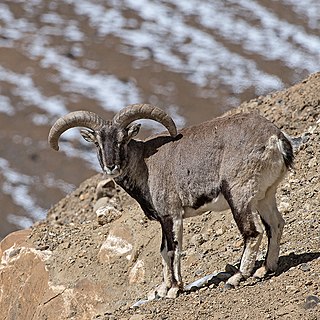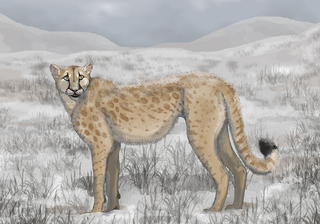The Neogene is a geologic period and system that spans 20.45 million years from the end of the Paleogene Period 23.03 million years ago (Mya) to the beginning of the present Quaternary Period 2.58 Mya. The Neogene is sub-divided into two epochs, the earlier Miocene and the later Pliocene. Some geologists assert that the Neogene cannot be clearly delineated from the modern geological period, the Quaternary. The term "Neogene" was coined in 1853 by the Austrian palaeontologist Moritz Hörnes (1815–1868).

The Pleistocene is the geological epoch that lasted from c. 2.58 million to 11,700 years ago, spanning the Earth's most recent period of repeated glaciations. Before a change was finally confirmed in 2009 by the International Union of Geological Sciences, the cutoff of the Pleistocene and the preceding Pliocene was regarded as being 1.806 million years Before Present (BP). Publications from earlier years may use either definition of the period. The end of the Pleistocene corresponds with the end of the last glacial period and also with the end of the Paleolithic age used in archaeology. The name is a combination of Ancient Greek πλεῖστος (pleîstos), meaning "most", and καινός, meaning "new".

A pika is a small, mountain-dwelling mammal native to Asia and North America. With short limbs, a very round body, an even coat of fur, and no external tail, they resemble their close relative, the rabbit, but with short, rounded ears. The large-eared pika of the Himalayas and nearby mountains lives at elevations of more than 6,000 m (20,000 ft).

Struthionidae is a family of flightless birds, containing the extant ostriches and their extinct relatives. The two extant species of ostrich are the common ostrich and Somali ostrich, both in the genus Struthio, which also contains several species known from Holocene fossils such as the Asian ostrich. The common ostrich is the more widespread of the two living species, and is the largest living bird species. The extinct genus Pachystruthio from the Late Pliocene-Early Pleistocene of Eurasia is one of the largest birds ever.

Gyps is a genus of Old World vultures that was proposed by Marie Jules César Savigny in 1809. Its members are sometimes known as griffon vultures. Gyps vultures have a slim head, a long slender neck with downy feathers, and a ruff around the neck formed by long buoyant feathers. The crown of their big beaks is a little compressed, and their big dark nostrils are set transverse to the beak. They have six or seven wing feathers, of which the first is the shortest and the fourth the longest.

The Tibetan Plateau, also known as the Qinghai–Tibet Plateau or the Qing–Zang Plateau or as the Himalayan Plateau in India, is a vast elevated plateau located at the intersection of Central, South and East Asia covering most of the Tibet Autonomous Region, most of Qinghai, western half of Sichuan, Southern Gansu provinces in Western China, southern Xinjiang, Bhutan, the Indian regions of Ladakh and Lahaul and Spiti as well as Gilgit-Baltistan in Pakistan, northwestern Nepal, eastern Tajikistan and southern Kyrgyzstan. It stretches approximately 1,000 kilometres (620 mi) north to south and 2,500 kilometres (1,600 mi) east to west. It is the world's highest and largest plateau above sea level, with an area of 2,500,000 square kilometres (970,000 sq mi). With an average elevation exceeding 4,500 metres (14,800 ft) and being surrounded by imposing mountain ranges that harbor the world's two highest summits, Mount Everest and K2, the Tibetan Plateau is often referred to as "the Roof of the World".

The mountain goat, also known as the Rocky Mountain goat, is a hoofed mammal endemic to mountainous areas of western North America. A subalpine to alpine species, it is a sure-footed climber commonly seen on cliffs and ice.

Ostriches are large flightless birds. They are the heaviest living birds, and lay the largest eggs of any living land animal. With the ability to run at 70 km/h (43.5 mph), they are the fastest birds on land. They are farmed worldwide, with significant industries in the Philippines and Namibia. Ostrich leather is a lucrative commodity, and the large feathers are used as plumes for the decoration of ceremonial headgear. Ostrich eggs have been used by humans for millennia.

The bharal, also called the blue sheep, is a caprine native to the high Himalayas. It is the only member of the genus Pseudois. It occurs in India, Bhutan, China, Myanmar, Nepal, and Pakistan. The Helan Mountains of Ningxia have the highest concentration of bharal in the world, with 15 bharals per km2 and 30,000 in total.

Miracinonyx is an extinct genus of felids belonging to the subfamily Felinae that was endemic to North America from the Pliocene to Pleistocene epochs and morphologically similar to the modern cheetah .The genus was originally known from fragments of skeletons, but nearly complete skeletons have been recovered from Natural Trap Cave in northern Wyoming.

Coelodonta is an extinct genus of rhinoceros that lived in Eurasia between 3.7 million years to 10,000 years ago, in the Pliocene and the Pleistocene epochs. It is best known from the type species, the woolly rhinoceros, which ranged throughout northern Eurasia during the Pleistocene. The earliest known species, Coelodonta thibetana, lived in Tibet during the Pliocene, with the genus spreading to the rest of Eurasia during the Pleistocene.

Sisoridae is a family of catfishes. These Asian catfishes live in fast-moving waters and often have adaptations that allow them to adhere to objects in their habitats. The family includes about 235 species.

The Himalayan wolf is a canine of debated taxonomy. It is distinguished by its genetic markers, with mitochondrial DNA indicating that it is genetically basal to the Holarctic gray wolf, genetically the same wolf as the Tibetan and Mongolian wolf, and has an association with the African wolf. No striking morphological differences are seen between the wolves from the Himalayas and those from Tibet. The Himalayan wolf lineage can be found living in Ladakh in the Himalayas, the Tibetan Plateau, and the mountains of Central Asia predominantly above 4,000 m (13,000 ft) in elevation because it has adapted to a low-oxygen environment, compared with other wolves that are found only at lower elevations.

The evolution of the horse, a mammal of the family Equidae, occurred over a geologic time scale of 50 million years, transforming the small, dog-sized, forest-dwelling Eohippus into the modern horse. Paleozoologists have been able to piece together a more complete outline of the evolutionary lineage of the modern horse than of any other animal. Much of this evolution took place in North America, where horses originated but became extinct about 10,000 years ago.

The white-tailed nuthatch is a species of bird in the family Sittidae. It ranges across the northern and northeastern parts of the Indian Subcontinent, existing mainly in the low-to-middle Himalayas, as well as associated mountain ranges. It is found in Bhutan, India, Laos, Myanmar, Nepal, Tibet and Thailand.

The snow leopard, also known commonly as the ounce, is a species of large cat in the genus Panthera of the family Felidae. The species is native to the mountain ranges of Central and South Asia. It is listed as Vulnerable on the IUCN Red List because the global population is estimated to number fewer than 10,000 mature individuals and is expected to decline about 10% by 2040. It is threatened by poaching and habitat destruction following infrastructural developments. It inhabits alpine and subalpine zones at elevations of 3,000–4,500 m (9,800–14,800 ft), ranging from eastern Afghanistan, the Himalayas and the Tibetan Plateau to southern Siberia, Mongolia and western China. In the northern part of its range, it also lives at lower elevations.

A gazelle is one of many antelope species in the genus Gazella. This article also deals with the seven species included in two further genera, Eudorcas and Nanger, which were formerly considered subgenera of Gazella. A third former subgenus, Procapra, includes three living species of Asian gazelles.

Coelodonta thibetana, the Tibetan woolly rhinoceros, is an extinct species of the genus Coelodonta native to western Himalayas that lived during the middle Pliocene epoch. C. thibetana is known from the holotype IVPP V15908, a partially complete skull including incomplete lower jaw preserved with full dentition. It was first named by Tao Deng, Xiaoming Wang, Mikael Fortelius, Qiang Li, Yang Wang, Zhijie J. Tseng, Gary T. Takeuchi, Joel E. Saylor, Laura K. Säilä and Guangpu Xie in 2011.
Deng Tao is a Chinese palaeontologist at the Institute of Vertebrate Paleontology and Paleoanthropology (IVPP), Chinese Academy of Sciences, who has made important fossil discoveries on Cenozoic mammals. He is a professor of vertebrate palaeontology, deputy director of the Academic Committee, and deputy director of Key Laboratory of Evolutionary Systematics of Vertebrates at IVPP.

Dihoplus is an extinct genus of rhinoceros that lived in Eurasia from the Late Miocene to Early Pleistocene.

















